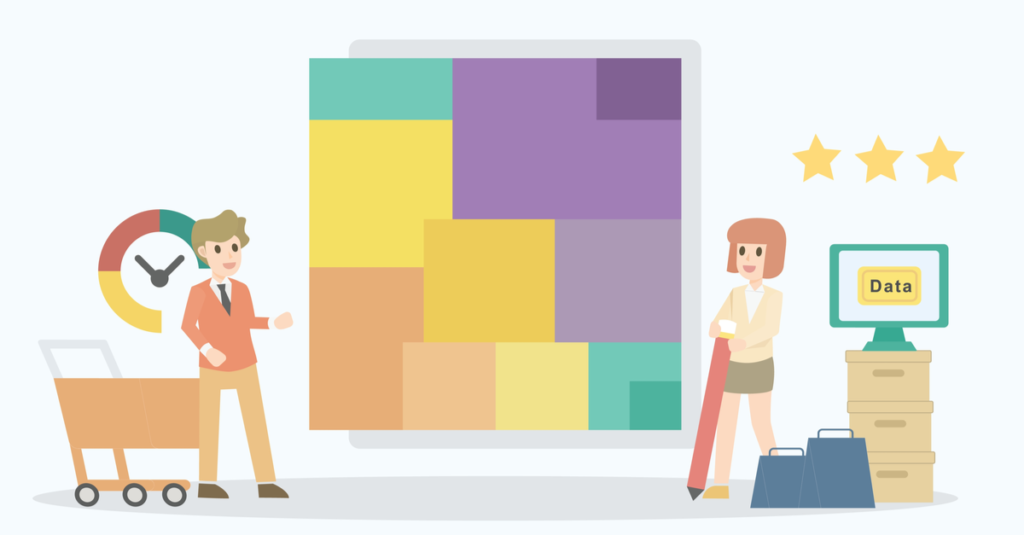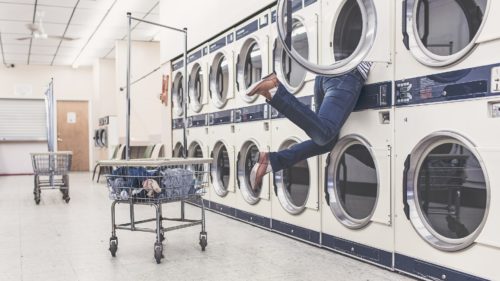It’s a simple calculation really,
number of customers × spend per customer = revenue
Yet it can still lead us astray.
Optimizing for quality, not just quantity
As marketers, we have traditionally focused on bringing in more customers. It’s all about attracting visitors that convert, as many customers as possible.
Spend per customer gets mostly left to chance. Maybe we put some effort into promoting products that are more expensive or that have a higher profit margin. But after that initial purchase, we lose enthusiasm for optimizing touchpoints to increase customer spend.
It’s common for marketers to have a PPC manager who spends 5 days a week working to bring in customers. Meanwhile, aspects such as the follow-up emails get set to endlessly repeat, or become someone’s small weekly blast.
Part of this bias is due to the data.
Numbers such as ad clicks are easy to measure with rapid changes in performance, so optimizing them feels more worthwhile. In the background are stats such as lifetime value or upsell performance. They are harder to measure with tools such as Google Analytics and require waiting weeks or months for changes to appear, so less attention is given to optimizing them.
“One of the quickest ways to add positive cash flow to your business is to figure out how to turn more of your one-time buyers into repeat customers”
Drew Sanocki, CEO Growth Engines
But a new range of tools and techniques are changing that. You can now directly test strategies for increasing the spend per customer, giving huge opportunities to boosting revenue.
Two knock-on effects from increasing your lifetime value
Not all customers are created equal. According to the Adobe Digital Index, 41% of revenue typically comes from 8% of visitors.
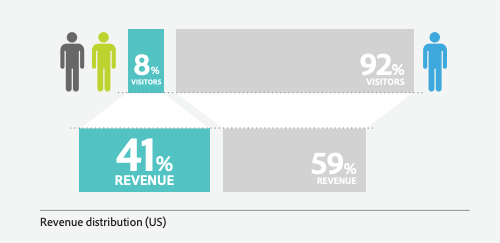
It is easy to think of the 80/20 rule as one of those inevitable laws of nature that you can’t influence. But, what if you could increase the number of big spenders?
On average, only 20% of the revenue from each sale is profit, with a whopping 15% going to marketing. That means if you can increase the amount of second purchases without big marketing spend, that second sale is almost twice as profitable.
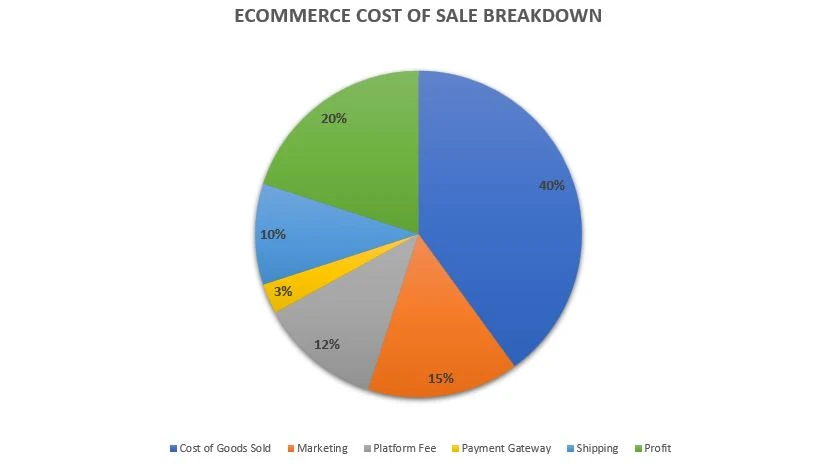
Meanwhile, increasing the average order value or amount of repeat purchases give you the ability to outbid competitors while staying profitable.
Two paths to boosting customer spend
There are two main approaches to boosting the amount spent per customers
- Increase the average order value (AOV)
- Nurture customers to increase lifetime value (LTV)
Most companies already try some tactics to increase both. They might have an “also bought” section along with sending a monthly newsletter to past customers about new products.
But there is also a whole range of underused tactics.
So, let’s take a look at some alternatives, along with suggested ways to measure their impact on optimizing each one or test which is best.
Tactics to increase average order value
If you use a platform such as Shopify or WooCommerce, then plugins are available that aim at boosting AOV. They modify the buying experience, adding extra suggestions or buying opportunities. The most common top of funnel “buying opportunities” are the cross-sell and the post-purchase upsell.
Cross-sell complementary products
Cross-selling is the classic “would you like fries with that?” add-on. It is all about suggesting extra items that would complement the one a customer is interested in.
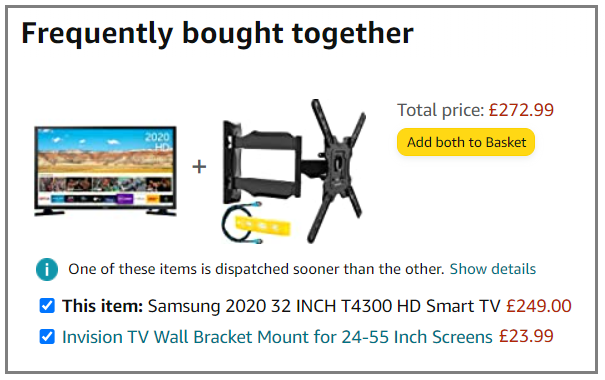
Cross-selling: suggesting a second product such as a relevant accessory
Amazon achieves this with their “frequently bought together” suggestions such as the bracket for the TV shown above.
Companies such as Wiser give any store the ability to add intelligent recommendations. From their case study with Kappa they describe:
“Kappa displays a ‘complete the look’ section on its product pages. In this section, it recommends products that fall under the same category the shopper is interested in but is from a different range.
“For example, if a shopper is looking for track pants in sportswear. You can use the ‘complete the look’ Wiser widget to recommend buying a t-shirt that would match with it.”
This one change gave an 11% increase in AOV
Post-purchase offer
Post-purchase offers are all about creating a second buying opportunity on the thank you page. The key advantage is that they don’t impact the original purchase as they don’t disrupt the primary sales funnel.
With tools such as CartHook, merchants see an average 10% increase in revenue!
They let merchants easily set up post-purchase funnels, customizing options such as timers and special discounts to encourage the sale. They then include some analytics to help users track the changes to AOV.
It is best to test whether a range of price points for the post-purchase offer. A small $15 product might convert better, whereas a $200 premium follow up could bring in more revenue.
How to measure product combinationsIf you want to measure which products are commonly bought together then check out SegMetrics.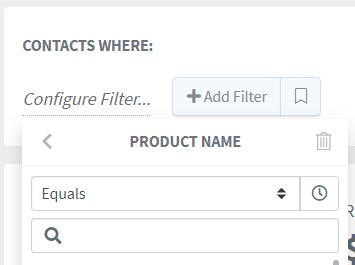 You can filter reports to see only customers whose purchases include a certain product. That lets you see what other products they bought either on that visit or the next time they came back. That lets you plan tactics to increase the AOV, or see which products would be best to promote in follow up emails. |
Going for the long game
So you bought in a new customer, fantastic! That’s great, but it doesn’t mean you can get complacent.
It’s easy to send out the usual stream of coupons and products announcements, with the risky assumption that some customers will inevitably come back to make more purchases.
Slacking off on nurturing new customers is a huge missed opportunity. Repeat customers typically spend more than new buyers, while bringing in higher profit margins from the reduced marketing costs. Even converting a few more percent of customers into repeat buyers can bring huge profit increases to a business.
Increasing lifetime value is all about building relationships with your customers.
Unlike AOV, it’s what happens after the purchase that counts. Do they have a particularly great experience with your product? Do you help them learn more about the business? Do you make them feel valued?
Or, do you only send them emails pushing them to buy the product, reducing the relationship to just a financial one?

Build the connection
Lowering the price via sales and discounts is only one way to increase the buying motivation.
You can also help customers appreciate the quality of your product…the reasoning behind it…the ways it can be used…how it differs from competitors…why they should stop putting off their decision.
Think of your email sequence as a chance to share details about your store that buyers wouldn’t otherwise find out. It’s about making the reader feel valued beyond the purchases they make, helping them share your vision.
Instead of adding the pile of coupons in their promotions tab, try a sequence based on building the brand perception. You could share information such as:
- The origin story of how your store began and how you got to this point
- Behind the scenes details of how you do things differently
- The values of your business and what they mean for customers
- Relevant advice and tips for getting the most out of your products
- Interviews with staff, customers, or industry experts
SendPulse shared a great example from Brooks Brothers, it builds the status of the brand through sharing the origin story before going on to share more recent innovations. It is not aimed at selling a specific product but instead building general brand perception.

The “winback” campaign
Every company has inactive subscribers. They’re the past customers who haven’t visited your website, clicked an email link or made a purchase in a long while.
The aim of a winback campaign is to recapture the attention of these past customers, to try and get them back as returning buyers. They are highly effective, with research showing that 45% of recipients who received a win-back campaign read a subsequent message [source: Martech].
Klaviyo recommends testing a short series of 2-5 emails, where the subject lines with a personal feeling such as “We miss you,” “Come back,” or “It’s been a while”.
These subject lines can lead to content such as offering discounts, information about new products or educating the customer.
You don’t have to aim to get an immediate sale. Try to build the curiosity back up, get the reader engaged so that they will make a purchase in the following months. To test which email series is most effective, measure the LTV associated with each one either by manipulating data from your existing platforms, or with a tool such as SegMetrics.
Taking it offline
Have you considered sending physical mailouts instead of only email blasts?
With prices as low as $0.70 per piece, it works out cheaper than clicking a remarketing ad. Plus, recipients get an item they can hang on to as a constant reminder to revisit your store.
Postalytics have a fantastic case study around running a winback campaign like above but with direct mail. Zogics, a gym company, sent the postcard below to past customers.
They used the Postalytics software to automate the process, integrating with Hubspot so that a postcard was sent to any customer who went quiet. The results were a 500% increase in ROI and an order volume increase of 140%
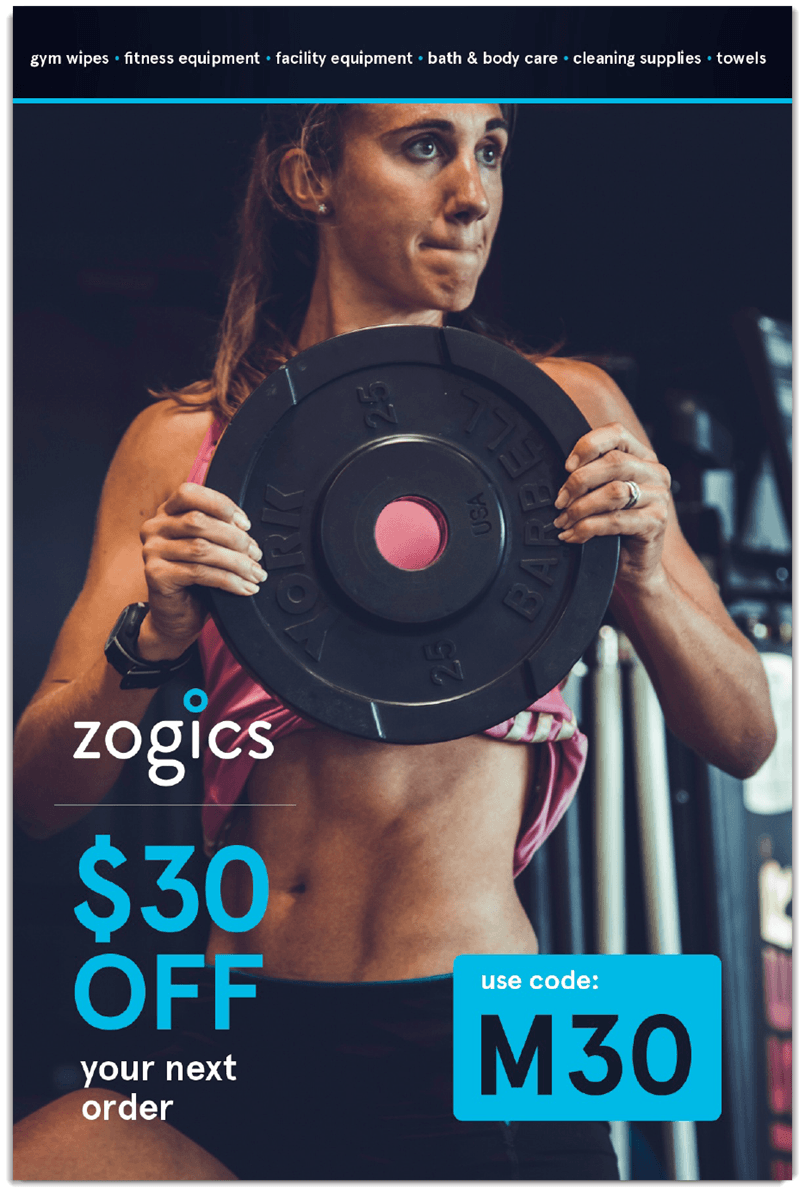
The wider statistics also back up the approach. For example “59 percent of U.S. respondents enjoy getting postal mail from brands about new products.”
Upgrade the experience
Bringing in repeat sales is about more than just product quality. What else could you be doing to upgrade the customer’s experience? It could be
- Premium or sustainable packaging
- Faster delivery (even for free shipping)
- Including small freebies or gifts
For example, Aeropress includes a sachet of ground coffee with each purchase. That gives buyers the opportunity to immediately put the product to use. This is backed up by research saying:
“60% of online shoppers said they’d be more likely to purchase from a retailer again upon receiving surprise giveaways (magnets, stickers, etc.) with an order” – Dotcom Dist
You don’t have to just blindly hope that there is an ROI when making these extra investments. Tools such as SegMetrics can let you split test what you are shipping to customers and see the LTV in the following months. (And with our free Split Test Calculator, you can confirm the winner of your split test.)
That way you can see if the freebie or next day delivery was worth the cost in terms of bringing back customers.
Upsell to a subscription
One-off purchases are great, but monthly revenue is even better. It can hold the potential for extreme increases in LTV, such as Oatly whose milk subscription increased LTV by 14x.
Subscription boxes have led the charge, but now other online stores are adding subscription options to their products. It is especially well suited to industries such as:
- Beauty products
- Fashion and clothing
- Food and beverages
- Health and wellness
- Home goods
- Pets and animals
Tools such as Recharge enable merchants to easily set up, promote and manage subscription products. They have great potential either as a primary product, or to upsell to buyers who were happy with their first purchase.
If you set up a subscription, it is important to properly attribute the sales. With SegMetrics you can see what campaigns bought in the initial purchases that then lead to a subscription.
How to measure changes in LTV
So hopefully you have some ideas you want to try out for increasing LTV.
But blindly picking one and hoping it pays off isn’t ideal. Iit’s best to instead test how each one impacts your revenue using the following steps:
- Create your new email sequence and set up the relevant automations
- Tag customers within your email platform to determine which approach you’re using with them
- Send them the relevant email or direct mail package and wait the desired time to see what happens
- There are two choices to analyze the impact
- Export the tag and revenue data from your email platform and manipulate it in Excel
- View the data directly in SegMetrics by comparing LTV per tag
- Boast to your boss about how much you increased revenue
SegMetrics can also attribute this LTV data back to your ad campaigns and traffic sources. You can discover which campaigns are more likely to bring in repeat customers and measure RoAS based on lifetime value.

